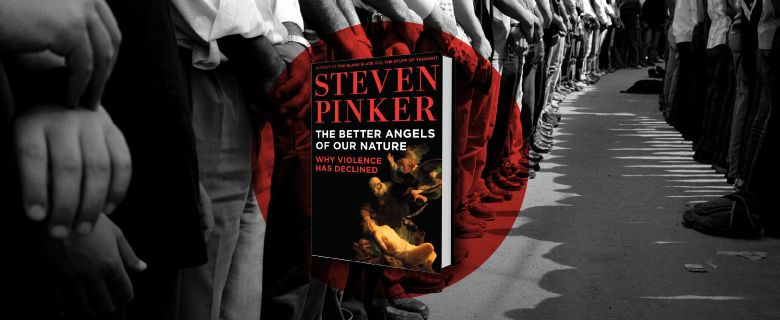A Critic's Meta Review:
Steven Pinker is a public intellectual, science writer and Harvard psychologist. His 2012 book; The Better Angels of Our Nature: Why Violence Has Declined oddly received criticism from the most likely of sources. Naysayers and pessimistic outrage cries anathema to a Pinker's brand of optimism. For me, human civilization needs this reality check of progress. If you want to label it as optimism, fine, Pinker has the data to back it up. Media outlets, planksip® not included, focus on the negative aspects of society, despite the headlines societies has become less, not more violent over time. Traditionally, historical narratives are constructed by selective historians. Self-evident tendencies towards perversion, gloom and doom present an interesting bias we must guard against. This book provides this foundation.
Post WWII peace counterpoints the trend of decreasing violence in a world of economic prosperity. Intuition points towards the death camps, fascist regimes and families living with memories of dogmatic ideologies gone awry. The risk of a war between nations, also common centuries ago, has diminished to the point of becoming virtually unthinkable. While wars between nations have become less frequent, other cataclysms, such as genocides, civil wars, and terrorism, have taken up a greater share of the total number of large-scale violent events humanity endures. But even these kinds of events have proven to be increasingly rare and less deadly in recent decades.
Along with the decline in large-scale violence, despite some high-profile incidents, such as the Rwandan genocide and the September 11, 2001 attacks, humanity has also seen a sharp decline in small-scale violence since the Second World War. Violence against minority groups, a phenomenon once commonly sanctioned by official policy, even in developed countries like the United States, has become less frequent as more people have come to recognize the humanity of people outside their sociocultural groups. Similarly, violence against women has declined sharply around the world, as women are afforded more rights and as more people recognize their inherent right to not be subjected to violence at the hands of their spouses or anyone else.
Given the decline in violence across the world, in not just one but many categories, it is tempting to believe that something has changed in human psychology to make people less prone to acting violently. In reality, people are just as prone to want to act violently against others as they ever were. Humans, like other mammals, have evolved to use violence in situations in which they feel threatened. But the human brain also possesses a capacity for weighing the consequences of violence. Over the last several centuries, human society has capitalized on that capacity by instilling reason in its social and political institutions.
Whether people realize it or not, a society built on reason is one that can address the root causes of violence so that violence becomes unnecessary. A reason-based society will, for instance, take measures to alleviate poverty so that people are less inclined to turn to crime to feed themselves. Reason-based institutions can resolve political differences through diplomacy, rather than through war, genocide, and terrorism. As this trend of increased rationalization continues, and human society increasingly uses reason to organize itself, people should expect rates of violence to continue to fall.
Despite common perceptions to the contrary, human society has become less, and not more violent over time.
People’s perceptions of history are naturally limited to their own time. When considering the violent atrocities which still happen around the world—such as urban crime, acts of terrorism, and the occasional war—it can be hard to appreciate that other periods in history were far more violent. However, thorough analysis of the best available statistics of historical violence suggests that humanity has been getting progressively less violent for centuries. It is reasonable to say that humans are less violent today than they have ever been, and that the trend is likely to continue into the future.
Since the publication of The Better Angels of Our Nature, the world has become both more and less violent by some measures. According to the Institute for Economics & Peace (IEP), an Australian think tank which quantifies levels of peace and violence around the world, 92 countries have become more violent since 2017, while only 71 countries became more peaceful. But while the world may have become more dangerous in the last few years, it has also become less bellicose. Since 2008, “the number of armed personnel per 100,000 people”—an indicator of how seriously a nation is preparing for war—has fallen in almost 120 countries. As a proportion of a country’s GDP, military spending also fell in more than 100 countries, and increased in fewer than 60 during that time. Short-term changes should not alter people’s overall perspective on the centuries-long trends shaping the world, however. As IEP notes in its report, “the deterioration in peacefulness in the last decade runs contrary to the longer term trend.” Despite some recent hiccups, in other words, the world is still becoming more peaceful.
Government emerged in human society largely to guarantee people’s safety.
As nomadic hunter-gatherer societies transformed over time into settled, urban societies, human health declined, often substantially. Despite such a major drawback, people continued to leave behind nomadic life to live settled lives on farms and in cities, until virtually no one lived as nomads. The reason may be that people considered the security of a centralized government a worthy tradeoff for a drop in living standards. Studies of the hunter-gatherer societies which still exist today show that people who live in them continue to exhibit a great deal of violence, even between family members.
Today, it is a popular assumption that people are less likely to suffer a violent death in rural than in urban areas. But, contrary to popular belief, a person may be safer in the big city than in the countryside, at least in the United States. For one 2013 study, a group of medical researchers analyzed data on around 1.3 million deaths resulting from injuries in the United States, and found that injury-related deaths were more common in rural than urban areas. Across the country, the two most frequent causes of fatal injury were firearms and car accidents. In rural areas, children below the age of 14 and people above the age of 45 were both more likely to suffer a gun-related death than city dwellers. Car accident-related deaths were an even more rural phenomenon, occurring with greater frequency in rural areas in every age category. Car accident deaths were also most frequent in the most rural parts of the country. One major reason for the discrepancy, the researchers suggested, may simply be that urban areas are more likely to have health care facilities well-equipped to handle life-threatening injuries than rural areas.
The history of Europe over the last 500 years shows that, as society becomes more cosmopolitan, it also becomes less violent.
The decline in urban violence in Europe over the last half millennium may come as a surprise to people who assume small villages to be the safest place for humans to live, and cities to be dangerous. But as the pioneering work of sociologist Norbert Elias found, greater urbanization led Europe to become safer. The reason is that cities allow for ever greater interaction between a variety of people. Extended social networks create a check on potential violence, as people come to recognize those from disparate social groups as fellow humans. As a consequence, their desire to inflict violence, even during times of disagreement, diminishes.
A recent decline in crime in New York City demonstrates how greater connectivity can lead to greater safety. Since 2013, murders, shootings, and robberies have fallen in the city’s public housing complexes by 22 percent. Across the city, crime has fallen every year for almost a quarter century. Part of the reason has been a rise in police activity, as New York has steadily increased the number of police officers and cameras around the city. But New York has also made some dramatic efforts to integrate the marginalized people most likely to commit violent crimes into the life of the city. Police work with a group of civilian “violence interrupters” who meet with families and friends of murder victims soon after the crime is committed to persuade them not to retaliate. Through grants to neighborhood organizations and direct interventions, the city provides additional services to high-crime areas, such as health fairs, art classes, counseling, and job training. According to one outside analysis, New York neighborhoods which have benefited from these programs have seen a steeper drop in gun violence than neighborhoods which have not.
Historically, as humans relied more on reason to guide their behaviors, they became less violent.
As people began living closer to each other and establishing laws based on reason rather than on irrational, often religious beliefs, they realized that violence was often counterproductive. Whereas primitive societies may have sacrificed people to appease fictitious gods, in rational societies, people recognized that human sacrifice had no appreciable effect on their quality of life. Recognizing how useless violence often was, these societies resorted to it less over time.
Terrorists who espouse extremist ideologies may know better than most people that isolating people increases their willingness to consider acting violently. According to a 2015 report by the United Nations Development Program (UNDP), terrorist groups often rely on physical isolation to create space to indoctrinate new recruits. The village of Gornja Maoča in Bosnia is a case in point. Already a remote village, it was isolated even further after falling under the control of Muslim extremists, who forbade unwanted outsiders from entering and posted ISIS flags at its entrances. Since taking over the village, extremists have lured many young men from around the Balkans to Gornja Maoča, where they’ve indoctrinated them, trained them with weapons, and sent them to fight in conflicts in Syria and Iraq. As of 2016, the Bosnian government estimated the number of Muslim extremists in the country to be around 3,000 and rising, as their communities continue to grow in isolated villages like Gornja Maoča.
Since about 1600, wars between nations have become a much rarer occurrence throughout the world.
Prior to the Treaty of Westphalia in 1648, Europeans were loosely affiliated with kingdoms and religious groups whose territories were poorly defined and often overlapped. As a result, wars were a near-constant occurrence as these groups frequently disagreed and relied on violence to resolve their disputes. After 1648, governments and nations became the primary mode of organizing human society in Europe, allowing for greater stability in Europe and, ultimately, throughout the world. The same period also saw the rise of professional armies and more sophisticated military technology which made war more deadly. But with greater stability, wars also became less frequent.
As nations have become more weary of costly interstate conflict, some military thinkers have observed that regional military powers, such as Russia, China, and Iran, have adopted new forms of warfare which combine political tactics and subversive military force. The new style of conflict is sometimes called “gray zone” conflict, as it exists between civilian and military action. One example of a gray zone conflict is Russia’s 2014 intervention in Ukraine. Aware that sending a large battalion of its own troops to Ukraine would invite retribution from the United States and its allies, Russia instead deployed a variety of tactics, few of which involved outright force. First it planted propaganda in Ukrainian social media networks to divide the country and build support for a Russian intervention among a sympathetic slice of the population. Then it conducted cyberattacks on key infrastructure to undermine power grids and gas supplies in target areas. Finally, Russia supplied allied rebels with weapons and deployed its own troops, but only in unmarked uniforms. Within the international community, the result was a confusion which hampered a timely response, as many nations, including the United States, were unsure whether or not Russia had actually invaded Ukraine.
The rates of mass violence from civil war, terrorism, and genocide have all fallen in recent decades.
While the decline of interstate warfare is an immensely positive historical trend, that fact alone does not tell the whole story of organized violence. As conflict between nations has decreased, other types of large-scale violence, such as conflicts within nations, genocides, and civil wars, have all taken up a larger proportion of the total number of violent events involving a large number of people. Fortunately, despite common perceptions, these events have become less common over time.
Terrorism, in particular, saw a dramatic about-face in the decade after 9/11. Although many pundits and scholars assumed the September 11, 2001 attacks on the United States signaled the start of a wave of mass violence committed in the name of Islam, within a decade, these kinds of terrorist acts, that is, those requiring an organized group of committed individuals acting in concert, have largely subsided. During the 2010s, counter-terrorism agencies in Western countries were equally, if not more concerned about lone-wolf terrorists. In such cases, a single person carries out an attack on a defenseless population completely alone and without help from any organization. In 2016, for instance, a single person drove a rented truck into a crowd in Nice, France, killing 86 people. But while such attacks are deadly, people acting alone are generally less able to inflict the mass destruction that groups of terrorists have done in the past.
As humans develop a stronger appreciation for each other’s right to life, abuses of human life are becoming more rare.
For decades, mob lynchings of African Americans were a common occurrence throughout much of the United States. But as the US government came to recognize and protect African Americans’ human rights, such lawless assaults on them rapidly became less common. Similarly, rape and spousal abuse of women were once widespread in the Western world. Rape and abuse are still a reality for many women, but in recent decades, these kinds of abuses have seen steep declines as governments and society more generally have recognized the rights of women. Throughout history, the pattern is clear: as more people recognize the rights of others, violence against them declines.
In the United States, the next form of mass violence to be phased out may be a sport. American football is a violent sport in which players are typically encouraged to inflict great bodily harm on each other. For decades, it has been one of the most popular, if not the most popular sport in the country. However, as revelations have mounted about professional and youth football players suffering chronic pain and permanent brain damage merely from playing the sport according to the rules, popular support for American football has decreased substantially. In January 2014, 40 percent of parents surveyed for an NBC-Wall Street Journal poll said they would encourage their children to play a sport other than football for fear of their child suffering a concussion. By January 2018, just four years later, the statistic had increased to 48 percent. The shift was most dramatic among mothers: between 2014 and 2018, the proportion of mothers surveyed who said they would encourage their child to play another sport rose from 40 to 53 percent.
Falling interest in playing amateur football parallels a drop in professional football viewership in the US. The proportion of people surveyed who said they followed professional football closely fell nine points, from 58 to 49 percent, between 2014 and 2018.
Despite the historical decline in violence, the human brain is no less prone to wanting to act violently.
Humans have not become less violent over time because they are biologically less inclined to commit acts of violence now than in centuries past. Human brains, just like many other animal brains, are hard-wired for aggression and violence. However, the human brain is unique in that it also has mechanisms to moderate aggression by weighing the utility and consequences of violence. Open societies take advantage of this feature by allowing people of different groups to interact, and recognize each other as fellow humans. As a result, people in open societies are less likely to inflict harm on each other.
In her book Political Tribes (2018), legal scholar Amy Chua writes that open societies, where people from different groups freely interact with each other, are the exception around the world and not the norm. Most of the world’s people live in exclusive, or “tribal” groups, where ethnic and religious identities are considered far more important than national affiliation. Since the Cold War, the United States has often attempted to foster free societies in countries where national identities were weak and tribal affiliations dominated. However, Chua notes, these efforts frequently exacerbated existing tribal tensions, leading to violence. One example of this phenomenon is South Vietnam. During the Vietnam War, the United States attempted to make the country prosperous by introducing free market capitalism. However, Chua observes that because the South Vietnamese economy was already dominated by an ethnic Chinese minority, the new, market-based economy disproportionately benefited this group over everyone else, deepening anti-Chinese resentment in the country. As a result, an effort to foster widespread prosperity and create an open society only made the society more closed, more tense, and, ultimately, more violent.
As humanity continues to apply reason to society, violence will likely continue to decline.
People may be more empathetic to the plights of others than they ever were before, but empathy alone cannot explain the decline in violence. Similarly, people may resist the temptation to inflict violence on one another because they are more able to maintain self-control than at other times in the past, but self-control is a psychological impulse that likewise cannot alone explain how human society has become more peaceful. The more likely reason that humanity has become less violent is that people rely more on reason to inform their decisions. By applying reason, people have built institutions to address society’s problems and reduce the need for violence in the first place.
In the United States, the criminal justice system in many states continues to execute people in the name of correcting society’s ills, despite overwhelming evidence that capital punishment does nothing to deter crime. However, as more stories proliferate in the American news media about people who were exonerated while awaiting execution, or even after they were executed, opposition to the ultimate punishment is rising. According to one 2016 poll conducted by the Pew Research Center, only 49 percent of Americans favored the death penalty for murderers. At the same time, 42 percent of Americans opposed it; this was the highest rate of opposition since 1972, the year the US Supreme Court banned capital punishment. The Court lifted the ban in 1977, and capital punishment has remained lawful ever since.
Undoubtedly, one reason opposition to capital punishment has increased in recent years is that more Americans are becoming aware of the worst aspects of the way it is used in the United States. According to a 2015 Pew survey, 84 percent of people who opposed the death penalty also correctly acknowledged there was some risk of executing an innocent person in the United States. By contrast, only 63 percent of people who supported capital punishment also recognized that such a risk existed. Meanwhile, 68 percent of people who opposed the death penalty also correctly acknowledged that minorities were more likely to be sentenced to die, while only 42 percent of people who supported the death penalty were aware of this statistical fact. The figures suggest that, the better informed Americans are about the facts of the death penalty, the more likely they are to oppose it.






